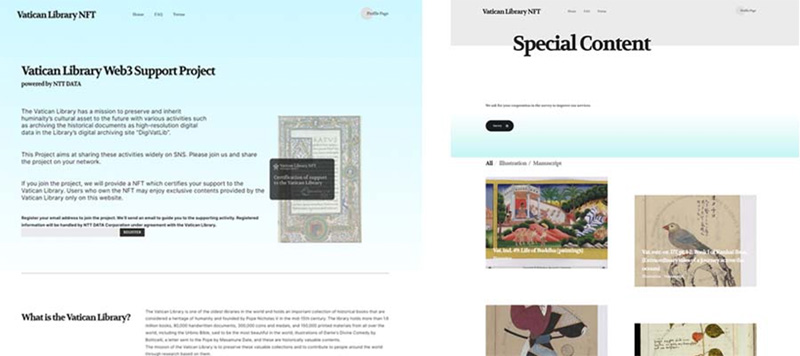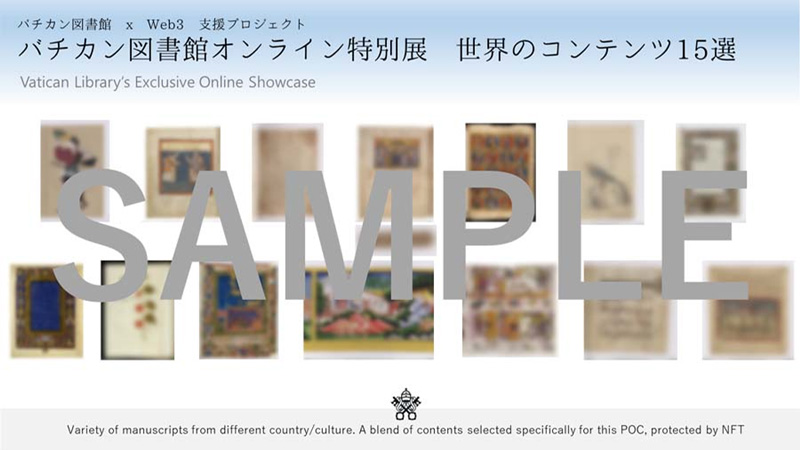Not just to 'store' but to 'utilize'.
What is value of digital archives in the Web3 era

Cultural assets are preserved in libraries and museums around the world, representing the footsteps of human history and possessing high rarity value, while also being constantly at risk of deterioration. In this context, digital archives are attracting attention.
We introduce NTT DATA's digital archive solution "AMLAD" and consider the future of digital archives that move beyond just "preserving" to "utilizing" phase, based on the efforts with the Vatican Library, which holds cultural assets from all over the world.
What is "AMLAD," which digitizes rare cultural assets into digital archives?
NTT DATA's digital archive solution "AMLAD®" supports the digital archiving of 2D and 3D data of valuable cultural assets held by public institutions and companies domestically and internationally. For example, overseas, the Vatican Apostolic Library("Vatican Library"), the ASEAN Secretariat, cultural institutions in Southeast Asian countries, and domestically in Japan, the Ishikawa Prefectural Library, Akita Prefectural Library, and Koyasan University are examples.
“Not only cultural institutions such as libraries and museums, but also corporate information assets are the subject of digital archiving. The range of its development is expanding year by year." says Akiyo Sato, who is involved in the AMLAD project at the Digital Solution Section.
Solution Development Group
Digital Solution Section, Social Innovation Division
Social Infrastructure Solution Sector, Akiyo Sato
In addition, Shiho Kondo from the same department also describes its features:
"We pay attention not only to preserving it in a beautiful state but also to the search system to quickly locate the data."
Solution Development Group
Digital Solution Section, Social Innovation Division
Social Infrastructure Solution Sector, Shiho Kondo
Leading the AMLAD team is Asahi Hasebe, who serves as the head of the department. He explained the importance and significance of digital archives.
"There are numerous valuable cultural assets sleeping in cultural institutions all over the world. However, they can only be seen by going to the location, and even if you go there, it is very difficult to find what you are looking for. However, if digital data is properly archived, you can easily and freely find and view what you want, no matter where you are in the world. This is the great significance of digital archives."
Sales & Planning Group/Solution Development Group
Digital Solution Section, Social Innovation Division
Social Infrastructure Solution Sector, Asahi Hasebe
Partnership with the Vatican Library, which holds cultural assets from around the world.
Since 2014, we have started a partnership with the Vatican Library to digitize and archive their valuable cultural assets, which include over 1.6 million books, more than 80,000 handwritten manuscripts, over 300,000 coins and medals, and over 150,000 printed materials.
"The Vatican Library was originally interested in digital archiving. It took two years from the first meeting to prepare for the digital archiving's public release. We have continued to partner with them since then. "(Hasebe)
We had the opportunity to speak with Cesare Pasini, Director of the Vatican Library, about the partnership with NTT DATA.
He reflected on the collaboration, saying, "Our holdings require careful attention for preservation. AMLAD's digital archive solution has contributed to the long-term preservation of these extremely valuable holdings without causing any damage. NTT DATA has played a major role in supporting our mission at the Vatican Library to publicly share the holdings collected from around the world, regardless of race, lineage, culture, religion, politics, or ideology, and to support research and scientific development."

Director Pasini speaks from Vatican.
The digital archive of the vast cultural assets held by the Vatican Library was not a straightforward process.
"It's not just a matter of creating digital data of the collections and storing it. We have to store it in accordance with international data structures that comply with the library's classifications and standards. In addition, there are local rules unique to the Vatican Library that must also be reflected in the system. It's a complex world." (Kondo)
"NTT DATA's strength is not just having the technology. We first deeply understand the background in which the client operates, such as their challenges, organizational structure, relevant laws, existing conventions and rules. Then, we provide a solution in the form of systematization. That's our strength." (Hasebe)
Many of the cultural assets that have actually been digitized into the digital archives are being utilized by researchers around the world.
"Especially during the COVID-19 pandemic when researchers couldn't visit the library, the digital archive became an important part of continuing the library's mission. Anyone, anywhere, could browse the digitized holdings by searching the catalog." (Director Pascuzzi)
Not just preserving, but utilizing. AMLAD enters a new stage.
The AMLAD team and the Vatican Library began to consider new possibilities for the digital archive.
"As we proceeded with the digital archive project, we began to question whether it was enough to simply 'preserve' the content. Saving, searching, and making it viewable... that may certainly be a valuable thing. But that alone does not bring out the value of the content. From now on, we should also consider 'utilizing' what we have saved." (Hasebe)
In February 2023, NTT DATA launched PoC with the Vatican Library to connect institutions that possess valuable digital content and their supporters using Web3 technology. In this experiment, supporters are recruited online for the Vatican Library and provided with rewards for their support using NFT and blockchain technology. Supporters apply for assistance through the website, and by sharing information about the project on social media, they receive NFTs that prove their support for the Vatican Library. By owning these NFTs, they can view high-resolution images of 15 cultural heritage items owned by the Vatican Library and explanatory texts created for those heritage items that were created for this project, on the website.
The "NFT that proves support for the Vatican Library" issued in this project will continue to exist in a tamper-proof manner permanently, and users who own it can freely show the proof to others. NTT DATA believes that utilizing the characteristics of such NFTs will lead to the creation of new online communities.

Figure1:「website for supporters」
Left:top page, Right:Contents viewing page(High-resolution images and explanatory text created by the Vatican Library will be displayed)

Figure 2:15 Contents posted on website(You can view high-resolution images on website.)
The Vatican Library also has great expectations for this initiative.
"It is not just the Vatican Library that sees value in the new communities that NTT DATA is creating. Surely, NTT DATA will continue to create new systems like this with various partners around the world." (Director Pascini)
Hasebe expresses that "the optimal technology has been found for what we want to do" regarding this initiative.
"The Web3 technology, with features such as being tamper-proof, persistent, and freely usable, is suitable for creating connections and communities based on individual intentions and trust. And creating new connections and communities based on digital content is nothing more than 'using' the digital archives we have been hoping for. In exploring the value and significance of Web3 throughout society, I believe that this project has the potential to be the first use case of the Web3 era." (Hasebe)

What each member envisions for the future of digital archives.
The future of digital archives lies in forming communities with supporters and cultural institutions or companies that possess rare content, not just limited to the Vatican Library. This is the vision that emerges from this proof-of-concept experiment, expanding online. The three members speak about the potential of AMLAD.
"For example, not only historical cultural assets, but also content such as contemporary art may be targeted. From 'AMLAD digitizes and archives old heritage' to 'AMLAD digitizes valuable content for utilization,' I believe that is the reason for our existence." (Hasebe)
"I would like to pay more attention to how we present the data. For example, transitioning from 2D data to 3D data, or even animating 3D data. If we add production values to not only preserve and display the data beautifully but also add value, I think the potential user base who can enjoy it will expand even more." (Kondo)
"Through this initiative, I hope to create a new way to contribute to cultural institutions. I want to create a system that not only 'preserves' cultural assets, but also generates new value that has never existed before, such as 'reaching more people, creating excitement, and connecting people.' I hope that this will contribute to the preservation and promotion of culture and art, and be of service to those involved in the cultural and art fields." (Sato)
Finally, after completing the PoC, leader Hasebe spoke about the future prospects. "As the world of Web3 begins, there will surely be changes on the digital front that we don't even know about yet. In a few years, there will surely be new norms that we cannot imagine from now. In the midst of that, we will create new connections and communities. This system is just the first step towards that. One thing I can say is that creating new norms requires services that have never existed before. And such services can only be born through practice, not just thinking with our heads. If we take action, the ripple effect will spread from our surroundings to society as a whole, and the norm will change. With that in mind, I just want to keep practicing." (Hasebe)
Summary
NTT DATA will continue to improve and expand its AMLAD service using Web3 technology based on the results of the pilot experiment with the Vatican Library. Additionally, they will collaborate with clients around the world, including the Vatican Library, to contribute to the preservation of valuable cultural heritage and build new communities with supporters from various countries and institutions.






